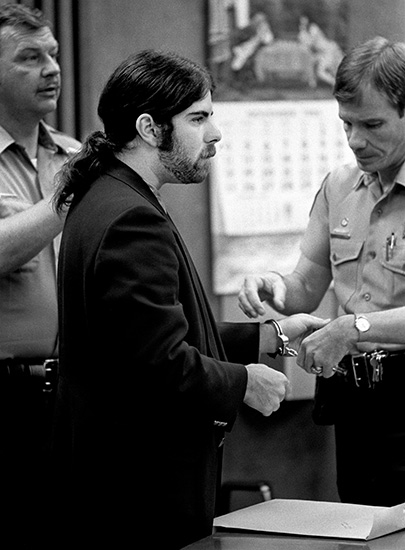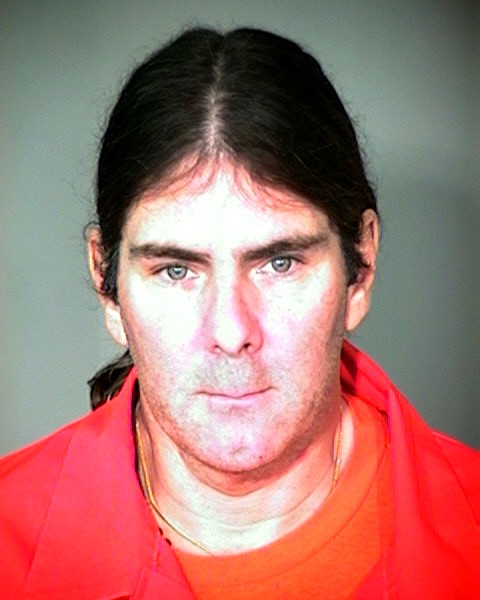Justice Delayed
Almost 20
years ago, the murder of an 8-year-old girl enraged Tucson; today, the
convicted killer remains alive on death row
By Chris
Limberis - TucsonWeekly.com
March 4, 2004
Vicki Lynne Hoskinson was a bright and cheery 8-year-old who had
completed her day at Homer Davis Elementary School. She pedaled her pink
bike that afternoon on what we all believed to be the safe streets of
Flowing Wells. She was heading back from dropping a birthday card into a
nearby mailbox.
Frank Jarvis Atwood was a 28-year-old pedophile, a
drifter from California who lived off his parents. He had been paroled
in May 1984 after serving prison time for a 1981 conviction; he'd been
found guilty of kidnapping an 8-year-old boy. Atwood asked the boy for
directions and then knocked down the boy's bike. He forced the boy to
fellate him.
He also had been busted in 1974 for lewd and
lascivious conduct with a 14-year-old girl and was sent to a mental
health facility.
He used his 9-year-old Datsun 280Z to get Vicki Lynne,
striking her bike with the car's bumper that bore telltale pink paint.
The bike lay on Pocito Place near Root Lane.
Vicki Lynne's sister found the bike, and her mother
rushed down the street to retrieve it. She called 911. Two teenage boys
saw the young girl in the black Z. A Homer Davis teacher also saw the
car, along with scruffy Atwood, and took down the license plate number.
Frank Jarvis Atwood returned later that day--Sept.
17, 1984--to his transient pals who were hanging out in De Anza Park on
East Speedway Boulevard at Stone Avenue. He had blood on his hands and
cactus needles on his pants. He boasted to his friends, including one
who was coincidentally struck and killed by lightning four days later,
that he stabbed a guy after a drug deal went awry. Atwood and his friend
Jack McDonald visited with another man and went to a bar to play pool.
Atwood's buddies noticed that he was spending time
sanding his knife. Atwood and McDonald left Tucson that night, taking
Interstate 10 on their way to New Orleans.
The Z broke down in Kerrville, Texas, less than an
hour from San Antonio. Atwood phoned home for help. McDonald heard this
significant part of that conversation: "Even if I did do it, you have to
help me."
The FBI had already called Atwood's parents, who told
agents that their son was getting his car fixed at Ken Stoepel Ford in
Kerrville. That's where they arrested him, searched his car and then
arranged for it to be carted to San Antonio, where it was searched again.
Ten days after Vicki Lynne Hoskinson disappeared,
Atwood was charged with kidnapping "with the intent to inflict death,
physical injury or a sexual offense on the victim." Nearly seven more
months passed before Vicki Lynne Hoskinson's remains were found.
Her family's immeasurable grief, the child's sweet
face and Atwood's demonic look fanned a huge and unprecedented community
and prosecutorial response. Victim's advocates groups, as well as and
law-and-punishment organizations, sprung up with stunning force.
The media circus moved north to Phoenix; the trial
was moved because of the overwhelming coverage. The trial didn't begin
until January 1987. Stanton Bloom, a highly skilled defense lawyer, took
over the case for Lamar Couser and pushed every limit, both procedurally
and physically (the always-fit Bloom was so drained that he was briefly
hospitalized), against an arrogant and rule-flouting, but effective,
John Davis.
The jury convicted Atwood on March 26, 1987. He was
sentenced on May 8, and the next day, he began his now-almost 17 years
on Arizona's death row. His only travel since has been the transfer of
death row from the old Cell Block 6 at the Florence prison to the Eyman
Unit east of Florence.
That didn't stop Atwood from getting married, at age
35, on Dec. 17, 1991, to Rachel Lee Tenny, 29, of Tucson. The marriage,
witnessed by Atwood's mother, was performed inside the old prison.
Atwood has studied enough to earn a degree in
comparative religion. But he'll never rehabilitate himself in the eyes
of most Tucsonans, who are simply awaiting his execution.
Atwood has burned just one appeal, one rejected not
long after Arizona resumed executions after a 29-year hiatus brought on
by changing laws and orders from the U.S. Supreme Court.
As lucky as he was to have a talented and tenacious
fighter like Bloom, Atwood is also fortunate to have Larry Hammond
handling his new appeal. Hammond, a genial lawyer who clerked for U.S.
Supreme Court Justices Lewis Powell and Hugo Black, is committed to
justice and equality. Fresh to Arizona, he and his Phoenix law-office
colleagues joined underfunded and outmanned Rubin Salter when African
Americans filed their landmark lawsuit against the Tucson Unified School
District for its decades of official and de facto segregation.
Hammond does not have any confidence in the press
when it comes to Atwood, whom he tries to see on a weekly basis. He does
not believe there has been one thing written about the case that has
been fair to Atwood. He believes emotions were further whipped up by
photos in which Atwood's creepy looks were somehow worsened to make him
look, as Hammond says, "like Charles Manson."
Hammond teaches courses at Arizona State University's
College of Law on wrongful convictions. He says he is convinced Atwood
did not receive a fair trial. "This case has been treated as if it is
the most clear example of a horrific crime in history.
"There is tremendous hatred for Frank," says Hammond,
who declines to offer any details on the appeal.
"Why on Earth would I want to talk to the arrogant,
ignorant press?" asks Hammond, who is considerably more gracious than
the comment would indicate. He adds that he would rather run through a
path of rattlesnakes than discuss Atwood's case with a reporter.
Only 22 men, of the 126 people on Arizona's death row,
have been there longer than Atwood. It is a stark and numbingly
depressing place. And the atmosphere changed in 1992, when shortly after
midnight on April 6, Don Eugene Harding, a runty and unbalanced man, was
killed in the gas chamber. The years of warehousing were over.
Harding overpowered and killed two salesmen at the La
Quinta, now a Ramada, just off of Interstate 10 at St. Mary's Road. At
his execution, Harding flipped off Attorney General Grant Woods, then
twisted and writhed and strained. His skin turned a supernatural deep
red; his body collapsed and then rose again against the restraints. It
took 10 minutes and 31 seconds for Harding to die. Prison officials who
witnessed Harding's predecessor, Manuel Silvas, die in the gas chamber
in March 1963, told reporters that it would be over quickly, with a gasp
of air and then unconsciousness.
Harding's death was so horrific that the state
Legislature moved with rare speed to allow voters to change the method
to lethal injection.
Defense lawyers and death-penalty abolitionists
feared Harding's execution would open the floodgates. But in 12 years,
there have been only 22 executions. Nine were executed for murders
committed in Pima County. The last execution was in November 2000, and
the U.S. Supreme Court's Ring decision--putting punishment in the
hands of the jury instead of the judge--has placed a number of death
cases in limbo.
As those sentences are sent to back to juries, the
abolitionist movement is evolving. Many death-penalty opponents no
longer want to coddle or glorify the killers they seek to keep alive.
They don't instantly insist on the innocence of those in prison. And
they are not in the business of forgiving those on death row for their
heinous crimes. They have genuine sympathy and concern for the families
and loved ones of the victims.
Until that is understood, they say, the abolition
movement will lack necessary support.
Meanwhile, Hammond works on Atwood's appeal, and
those who remember Vicki Lynne Hoskinson keep waiting.



